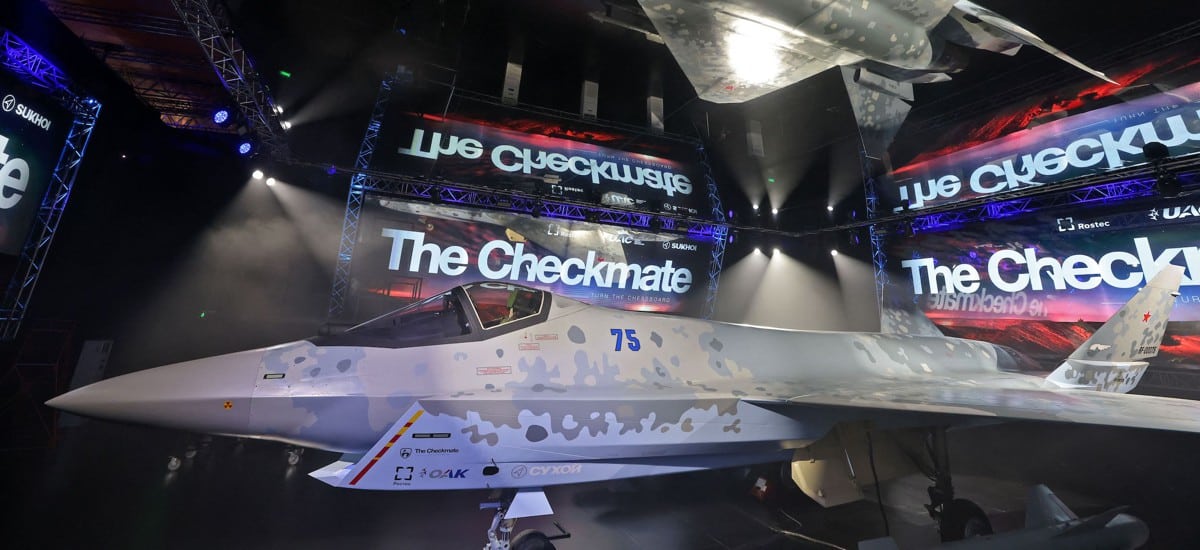Aviation
Su-75 Checkmate Fighter Jet Concept Reveals Major Design Changes for Enhanced Performance

Recently, Russia released the eagerly awaited Su-75 Checkmate, its most recent fighter jet design. With a focus on enhancing performance and stealth abilities, the aircraft has undergone substantial design modifications. The improved aerodynamics and smaller radar cross-section of the aircraft are highlighted in the new concept images, which also show other modifications.
Yury Slyusar, CEO of the company, said the company’s strategies while noting that the Checkmate project makes use of cutting-edge supercomputer technologies. Because of this, the business can begin the flight tests as early as 2024 and drastically cut the prototype construction time.
The new fighter has numerous significant modifications aimed at improving flight performance and stealth capabilities. The nose cone has been sawtooth-patterned to improve aerodynamic qualities while considerably lowering radar cross-section.
Additionally, the wing root form has been modified to optimize airflow and minimize drag, resulting in improved maneuverability and overall efficiency. The flaperon, a control surface positioned on the wing, has been significantly enlarged and extended towards the back of the aircraft. This enhancement increases control authority and allows for precise maneuvering in a variety of flight modes.
One of the key aspects of the Su-75 Checkmate is its stealthy design. The aircraft incorporates a reduced radar cross-section, advanced composite materials, and optimized shaping to minimize its visibility to enemy radars. This stealth capability allows the Su-75 to penetrate hostile airspace with reduced risk of detection, enabling it to carry out precision strikes and other missions with a higher chance of success.
The aft strakes, which are lateral aerodynamic surfaces on the fuselage’s back, have also been expanded. The aircraft’s performance in terms of stability, control, and high-angle-of-attack are improved by these changes, together with the enlarged strake flaps.
These extensive design changes result in an aircraft that has better flight characteristics, superior agility, and increased stealth capabilities. This fighter is more maneuverable, effective, and substantially harder to spot in a variety of operational conditions with its sawtooth-treated nose cone, modified wing root form, expanded flaperon, extended aft-strakes, and redesigned vertical stabilizer assembly.
The Su-75 Checkmate is about ready for the next phase of development, which will include flight testing and evaluation. Its introduction demonstrates Russia’s dedication to innovations in military aviation as well as the country’s ambition to compete with other top manufacturers in the global fighter jet sector.

Aviation
COMAC Unveils Plans for the C929 to Rival Airbus and Boeing

After the success of China’s first C919 aircraft, the country is setting its sights on developing a larger plane. COMAC (Commercial Aircraft Corporation of China) has officially confirmed plans to build a widebody aircraft, marking a significant step in its aircraft lineup.
Traditionally, Airbus and Boeing dominate the widebody aircraft market, with decades of expertise in developing planes and engines capable of carrying heavy payloads. China, which currently relies on imported engines, is now aiming to challenge these giants with its own widebody jet, the C929, designed to compete with the Airbus A350 and Boeing 777.
American Airlines Is Looking for Flight Attendants: Apply Now
The C929 will be China’s first independently developed long-range widebody aircraft. It adheres to international airworthiness standards and boasts independent intellectual property rights. The baseline version is designed to seat 280 passengers and offers a range of 12,000 kilometers, catering to global demand for both regional and international air travel.
Russia, which also needs reliable narrowbody and widebody aircraft, could become a key customer for the C929. Additionally, China plans to target the broader Asian market as it continues to expand its aviation capabilities.
Close Call at Heathrow: BA Flight Narrowly Escapes Drone Collision
China’s aviation progress includes the ARJ21 (now called C909), a regional jet with 100 seats for shorter routes, and the C919, a narrowbody jet with 180 seats designed to rival the Boeing 737 MAX and Airbus A320. Both models have found increasing demand in the domestic market.
At China’s largest air show in Zhuhai, COMAC announced that Air China will be the launch customer for the C929 widebody jet, though details about order size and delivery timelines were not disclosed.
Other major deals announced by COMAC include:
- Hainan Airlines: Firm orders for 60 C919 and 40 C909 regional jets.
- Colorful Guizhou Airlines: 30 C909 jets, with 20 firm orders and 10 provisional agreements.
The C929, renamed from the CR929 after Russia withdrew from the joint development project in 2023, is expected to carry 280–400 passengers with a range of 12,000 kilometers, competing directly with Boeing’s 787 Dreamliner.
According to COMAC’s deputy general manager, Tong Yu, the first fuselage section of the C929 is expected by September 2027, with prototype test flights anticipated soon after.
-

 Aviation2 months ago
Aviation2 months agoMicrosoft Flight Simulator Raises $3 Million to Bring Back the An-225 Mriya
-

 Airlines2 months ago
Airlines2 months agoQantas Engineers Stage Walkout Over Cost of Living Concerns
-

 Airlines2 months ago
Airlines2 months agoQatar Citizens Can Travel to the United States Without a Visa
-

 Aviation2 months ago
Aviation2 months agoQatar Airways bans these new Electronic Devices on plane
-

 Airlines2 months ago
Airlines2 months agoJapan Airlines Rolls Out Free Domestic Flights to International Passengers
-

 Defence2 months ago
Defence2 months agoWhich Country Has the Largest Fleet of Fighter Aircraft?
-

 Airport2 months ago
Airport2 months agoWestern Sydney Airport Welcomes Its First Plane After 6 Years of construction
-

 Aviation2 months ago
Aviation2 months agoDid you know ? Once Boeing 747 carried 1088 passenger in 1991








